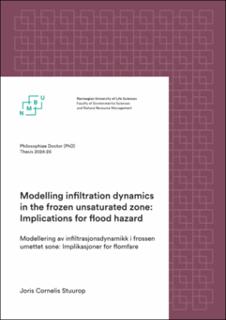| dc.contributor.advisor | French, Helen Kristine | |
| dc.contributor.advisor | van der Zee, Sjoerd E.A.T.M. | |
| dc.contributor.advisor | Voss, Clifford I. | |
| dc.contributor.author | Stuurop, Joris Cornelis | |
| dc.date.accessioned | 2024-04-25T07:32:33Z | |
| dc.date.available | 2024-04-25T07:32:33Z | |
| dc.date.issued | 2024 | |
| dc.identifier.isbn | 978-82-575-2104-2 | |
| dc.identifier.issn | 1894-6402 | |
| dc.identifier.uri | https://hdl.handle.net/11250/3128027 | |
| dc.description.abstract | This PhD research investigated numerical modelling of frozen soil, implications of soil freezing on infiltration, snowmelt flooding in an agricultural landscape, and literature on soil freezing physics. The main goal was to better understand frozen soil conditions that lead to infiltration capacity decrease and thus increased flood hazard. The work resulted in five manuscripts of which three are published at the time of writing, and two are drafts. First, a numerical model called CryoFlow was developed to simulate water and heat transport in soil with phase change. Three different approaches were tested against experimental data: a physically-based, semiempirical and empirical approach. These entailed different functions for freezing point depression and for matric potential change due to freezing (cryosuction). It was found that all variants predicted experimental results well. The semi-empirical version was however preferred because it required the least amount of empirical parameters and was therefore used for the remainder of the research. Secondly, numerical simulation of a large number of scenarios revealed the influence of soil water content, boundary temperature conditions, water input rate, soil type, microtopography, and macropores on frozen soil infiltration capacity. Specific combinations of variables and conditions were associated with various amounts of infiltration reduction (and thus increased flood hazard). Thirdly, fieldwork was carried out in a small agricultural catchment to better understand flooding and erosion due to snowmelt. Groundwater seepage was found to initiate substantial surface runoff and erosion, while in a prior winter the cause was found to be frozen soil. Finally, an overview was written of current theory and knowledge gaps concerning various aspects of frozen soil physics, such as matric potential increase with phase change, and the permeability decrease because of decreasing liquid water content. | en_US |
| dc.description.abstract | I dette doktorgradsarbeidet er konsekvensene av jordfrysing for infiltrasjon under snøsmelting og mulig bidrag til flom undersøkt ved hjelp av numerisk modellering av frossen jord med ulike fysiske egenskaper. Den numeriske modellen er basert på tidligere dokumentasjon om fryse og tineprosesser i litteraturen.. Hovedmålet var å bedre forståelsen av forhold som fører til redusert infiltrasjonskapasitet i frossen jord, og dermed økt flomrisiko. Arbeidet har resultert i fem manuskripter, hvorav tre er publisert og to er utkast, på tidspunktet for innlevering av avhandlingen. . Først ble den numeriske modellen, kalt CryoFlow, utviklet for å simulere vann- og varmetransport i jord med faseforandring. Tre forskjellige tilnærminger ble testet mot eksperimentelle data: en fysisk-basert, semi-empirisk og empirisk tilnærming. Disse innebar forskjellige funksjoner for å beskrive frysepunktreduksjon og endring av matrikspotensial på grunn av frysing (frostindusert matrikspotensial). Alle de testede funksjonene predikerte eksperimentelle resultater godt. Den semi-empiriske versjonen ble imidlertid foretrukket for det videre arbeidet fordi den krever færrest empiriske parametere. Videre viste de numerisk simuleringene av et stort antall scenarioer , med forskjellig kombinasjoner av initialbetingelser av vanninnhold, temperatur (jord og ved overflaten)infiltrasjonsrater, jordtyper, mikrotopografi og makroporer, effekten på infiltrasjonskapasiteten til frossen jord. Spesifikke kombinasjoner av variabler og fysiske forhold ga forskjellig reduksjon av infiltrasjonsmengde (og dermed flomrisiko). For det tredje ble det utført feltarbeid i et lite landbruksdominert nedbørfelt for å bedre forståelsen av flom og erosjon på grunn av snøsmelting. Grunnvannsutstrømning observert her viste seg å initiere betydelig overflateavrenning og erosjon, mens frost var dominerende årsak tidligere vintere. Til slutt ble det skrevet en oversikt over gjeldende teori og kunnskapshull om fysiske prosesser i frossen jord, slik som matrikspotensialøkning med faseforandring, og reduksjon i vannledningsevne på grunn av redusert flytende vanninnhold. | en_US |
| dc.language.iso | eng | en_US |
| dc.publisher | Norwegian University of Life Sciences, Ås | en_US |
| dc.relation.ispartofseries | PhD thesis;2024:25 | |
| dc.rights | Attribution-NonCommercial-NoDerivatives 4.0 Internasjonal | * |
| dc.rights.uri | http://creativecommons.org/licenses/by-nc-nd/4.0/deed.no | * |
| dc.title | Modelling infiltration dynamics in the frozen unsaturated zone : implications for flood hazard | en_US |
| dc.title.alternative | Modellering av infiltrasjonsdynamikk i frossen umettet sone : implikasjoner for flomfare | en_US |
| dc.type | Doctoral thesis | en_US |

